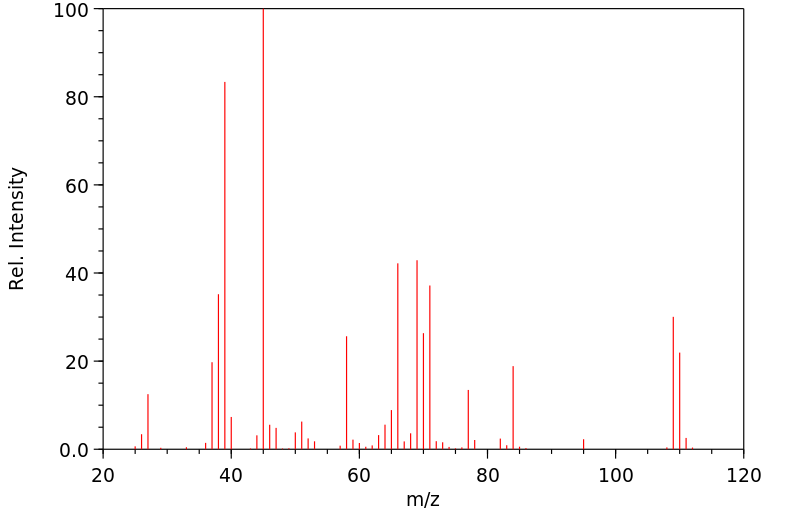二炔丙基硫醚 | 13702-09-5
中文名称
二炔丙基硫醚
中文别名
丙炔基硫醚
英文名称
dipropargyl sulfide
英文别名
bispropargyl sulfide;di(prop-2-yn-1-yl)sulfane;3-prop-2-ynylsulfanylprop-1-yne
CAS
13702-09-5
化学式
C6H6S
mdl
——
分子量
110.18
InChiKey
XPTMJJIPRSWBDK-UHFFFAOYSA-N
BEILSTEIN
——
EINECS
——
-
物化性质
-
计算性质
-
ADMET
-
安全信息
-
SDS
-
制备方法与用途
-
上下游信息
-
文献信息
-
表征谱图
-
同类化合物
-
相关功能分类
-
相关结构分类
物化性质
-
熔点:4 °C
-
沸点:59°C/14mmHg(lit.)
-
密度:1.010±0.06 g/cm3(Predicted)
-
溶解度:可溶于氯仿(少许)、甲醇(少许)
-
保留指数:862;862
计算性质
-
辛醇/水分配系数(LogP):1.1
-
重原子数:7
-
可旋转键数:2
-
环数:0.0
-
sp3杂化的碳原子比例:0.33
-
拓扑面积:25.3
-
氢给体数:0
-
氢受体数:1
安全信息
-
危险等级:3
-
危险品运输编号:UN 1993 3/PG III
-
海关编码:2930909090
-
包装等级:III
-
危险类别:3
-
储存条件:温度应控制在0-10°C之间,并且要避免加热。
SDS
制备方法与用途
聚合物负载型试剂
上下游信息
反应信息
-
作为反应物:描述:二炔丙基硫醚 在 N-溴代丁二酰亚胺(NBS) 、 四(三苯基膦)钯 、 氧气 、 potassium iodide 、 palladium(II) iodide 作用下, 以 N,N-二甲基甲酰胺 为溶剂, -20.0~40.0 ℃ 、2.03 MPa 条件下, 反应 6.0h, 生成 3,4,3",4"-tetra<(methoxycarbonyl)methyl>-2,2',2"-terthiophene参考文献:名称:Synthesis of 3,4-bis[(methoxycarbonyl)methyl]thiophene and bis-, ter- and pentathiophenes with alternating 3,4-bis[(methoxycarbonyl)methyl]-substituted rings摘要:The synthesis of 3,4-bis[(methoxycarbonyl)methyl]thiophene and bis-, ter- and pentathiophenes, with alternating 3,4-bis(methoxycarbonyl)methyl-substituted rings, is reported, These new thiophene derivatives are possible precursors for the preparation of new conducting polymers useful as materials for electronics. (C) 1998 Elsevier Science Ltd. All rights reserved.DOI:10.1016/s0040-4020(98)01047-3
-
作为产物:参考文献:名称:HDDA 衍生的苯与硫化物的反应:机理、模式和三组分反应摘要:我们在这里报告了烷基硫化物与通过六氢-狄尔斯-阿尔德 (HDDA) 环异构化热产生的苄的反应。最初产生的 1,3-甜菜碱(o-锍/芳基碳负离子)经历分子内质子转移以产生更稳定的 S-芳基硫叶立德。这可以以各种方式反应,包括在反应介质中加入弱酸 (HA)。这会产生瞬态离子对 ArSR2(+)A(-),然后再生成 ArSR + RA。当使用环状硫化物时,A(-) 开环并结合到产品中,这一结果构成了多功能的三组分偶联过程。DOI:10.1021/jacs.6b01025
文献信息
-
[EN] ELECTROCHEMICALLY-CLEAVABLE LINKERS<br/>[FR] LIEURS CLIVABLES PAR VOIE ÉLECTROCHIMIQUE申请人:MICROSOFT TECHNOLOGY LICENSING LLC公开号:WO2021158412A1公开(公告)日:2021-08-12This disclosure provides electrochemically-cleavable linkers with cleavage potentials that are less than the redox potential of the solvent in which the linkers are used. In some applications, the solvent may be water or an aqueous buffer solution. The linkers may be used to link a nucleotide to a bound group. The linkers include a cleavable group which may be one of a methoxybenzyl alcohol, an ester, a propargyl thioether, or a trichloroethyl ether. The linkers may be cleaved in solvent by generating an electrode potential that is less than the redox potential of the solvent. In some implementations, an electrode array may be used to generate localized electrode potentials which selectively cleave linkers bound to the activated electrode. Uses for the linkers include attachment of blocking groups to nucleotides in enzymatic oligonucleotide synthesis.
-
Ruthenium(II)-Catalyzed Selective Intramolecular [2 + 2 + 2] Alkyne Cyclotrimerizations作者:Yoshihiko Yamamoto、Takayasu Arakawa、Ryuji Ogawa、Kenji ItohDOI:10.1021/ja0358697日期:2003.10.1containing functional groups such as ester, ketone, nitrile, amine, alcohol, sulfide, etc. can be used for the present ruthenium catalysis. The most significant advantage of this protocol is that the cycloaddition of unsymmetrical 1,6-diynes with one internal alkyne moiety regioselectively gave rise to meta-substituted products with excellent regioselectivity. Completely intramolecular alkyne cyclotrimerization在催化量的 Cp*RuCl(cod) 存在下,1,6-二炔在环境温度下与单炔进行化学选择性反应,以良好的产率得到所需的双环苯衍生物。多种含有官能团如酯、酮、腈、胺、醇、硫化物等的二炔和单炔可用于本发明的钌催化。该协议最显着的优点是不对称 1,6-二炔与一个内部炔烃部分的环加成区域选择性产生了具有优异区域选择性的间位取代产品。完全分子内炔烃环三聚也使用三炔底物完成,以获得与 5-7 元环稠合的三环芳族化合物。与这些环三聚反应相关的 ruthenabicycle 复合物是由 Cp*RuCl(cod) 和具有苯基端基的 1,6-二炔合成的,其结构由 X 射线分析明确确定。这种钌环中间体的中间体通过它与乙炔的反应得到了进一步证实,产生了预期的环加合物。环三聚机制的密度泛函研究表明,环三聚通过氧化环化进行,产生一个钌环中间体,随后由合成的钌环与炔烃的正式 [2 + 2] 环加成引发的炔烃插入。这种钌
-
Ruthenium-Catalyzed Cycloaddition of 1,6-Diynes and Nitriles under Mild Conditions: Role of the Coordinating Group of Nitriles作者:Yoshihiko Yamamoto、Keisuke Kinpara、Ryuji Ogawa、Hisao Nishiyama、Kenji ItohDOI:10.1002/chem.200600176日期:2006.7.17to afford bicyclic pyridines. Careful screening of nitrile components revealed that a C[triple chemical bond]C triple bond or heteroatom substituents, such as methoxy and methylthio groups, proved to act as the coordinating groups, whereas C==C or C==O double bonds and amino groups failed to promote cycloaddition. This suggests that coordinating groups with multiple pi-bonds or lone pairs are essential
-
Preparation of Structurally and Electronically Diverse N → B-Ladder Boranes by [2 + 2 + 2] Cycloaddition作者:Jonas D. W. Schepper、Andreas Orthaber、Frank PammerDOI:10.1021/acs.joc.1c01402日期:2021.11.5We report the synthesis of a series of eight N → B-ladder boranes through cobalt-mediated cyclotrimerization of (2-cyanophenyl)-dimesitylborane with different dialkynes. The resulting tetracoordinate boranes show variable electrochemical and optical properties depending on the substitution pattern in the backbone of the coordinating pyridine-derivatives. While boranes containing alkyl-substituted pyridines
-
Cp*RuCl-Catalyzed [2 + 2 + 2] Cycloadditions of α,ω-Diynes with Electron-Deficient Carbon−Heteroatom Multiple Bonds Leading to Heterocycles作者:Yoshihiko Yamamoto、Keisuke Kinpara、Tomoaki Saigoku、Hideyuki Takagishi、Satoshi Okuda、Hisao Nishiyama、Kenji ItohDOI:10.1021/ja045694g日期:2005.1.1In the presence of a catalytic amount of Cp*RuCl(cod), 1,6-diynes were allowed to react chemo- and regioselectively with electron-deficient nitriles and heterocumulenes at 60−90 °C to afford heterocyclic compounds. The mechanism of the ruthenium-catalyzed regioselective formations of bicyclic pyridines and pyridones were analyzed on the basis of density functional calculations. Cyclocotrimerizations
表征谱图
-
氢谱1HNMR
-
质谱MS
-
碳谱13CNMR
-
红外IR
-
拉曼Raman
-
峰位数据
-
峰位匹配
-
表征信息
同类化合物
锗烷,三甲基[3-(三甲基甲锡烷基)-2-炔丙基]-
锗烷,三甲基-2-炔丙基-
铜,1-戊炔基-
甲基炔丙基硫化物
甲基乙炔和丙二烯混合物
甲基丙-2-炔基氰基二硫代亚氨酸酯
甲基-D3-乙炔
环戊基乙炔
环己基乙炔
环丙乙炔
炔丙胺
炔丙基膦
炔丙基碘化物
炔丙基叔丁基二甲基硅烷
炔丙基三甲基硅烷
炔丙基三乙基硅烷
氘乙炔
戊-1-炔-3-胺
戊-1,3-二炔
戊-1,2-二烯-4-炔
异氰基-乙炔
己基(己-5-炔基)甲基硅烷
己-1-炔银
四碳化铀
反式-4-(2-丙炔基)-环己烷甲醇
双(三甲基锡)乙炔
双(三氟甲基)锌
十四碳-1,4-二炔
十四碳-1,3-二炔
十八碳-1,17-二炔
十八炔
十三碳-1,7-二炔
十三碳-1,12-二炔
十一碳-1,5-二炔
亚硫酸二(2-丙炔基)酯
二甲基炔丙基溴化硫
二炔丙基硫醚
二乙炔基-二甲基-锗烷
二丙-1-炔基汞
二[2-甲氧基乙基汞(II)]乙炔
二(三正丁基甲锡烷基)乙炔
二(3-羟基-1-丙炔基)汞(II)
乙炔锂乙二胺配合物
乙炔银
乙炔基环己烷钠
乙炔基环丙烷氯化镁
乙炔基(三甲基)锗烷
乙炔基(三甲基)硅烷铜(1+)
乙炔基(三甲基)硅烷溴化镁
乙炔基(三甲基)硅烷氯化镁







